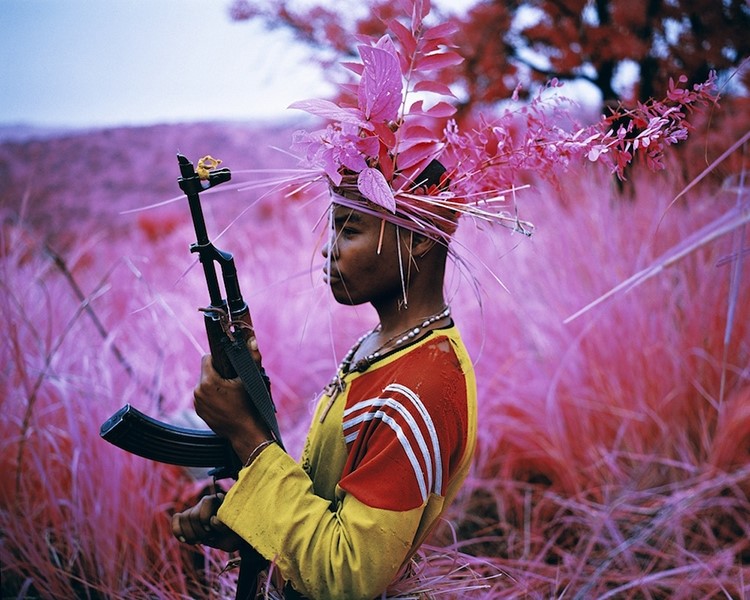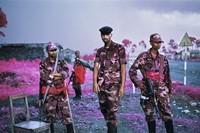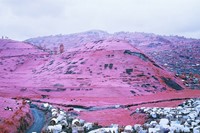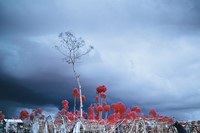Using an infrared film developed by Kodak and the military for the detection of camouflage, Mosse’s moving image work The Enclave explored the war zone and humanitarian disaster currently taking place in the Democratic Republic of Congo...
The palette of war photography has long been established as green, brown, black, red. Camouflage, dirt, guns, blood. Richard Mosse, in his installation for the Irish Pavilion at the 2013 Venice Biennale, chose to shine a new light on the coverage of conflict, literally. Using an infrared film developed by Kodak and the military for the detection of camouflage, Mosse’s moving image work The Enclave explored the war zone and humanitarian disaster currently taking place in the Democratic Republic of Congo, rendering its scenes of horror, despair, bravado and destruction in vibrant magenta, scarlet, puce and purple.
Mosse first worked with this film in his photography project Infra, describing The Enclave as the culmination of this work. The effects are at first mesmerisingly beautiful and seductive, landscapes and people glazed in a surrealist wash of shocking pink. Yet as the truth of the subjects push through the pink, the colours become less fantastical, more grotesque and terrifying. A boy in a headdress of leaves loses his Peter Pan charm as the deadliness of his rifle becomes the focus. Candyfloss trees behind throw the skeletons, ragged tents and tombstones into sharper relief. This is a world without rules – not even of colour – and Mosse’s fairytale patinas force the reality to the surface more profoundly than the established tropes of war coverage that we are often so inured to.
Here, as the dust of the Biennale settles, Mosse talks to AnOther about the inception of The Enclave and the pursuit of the sublime amid the horrors of the Congo.
Infra is an extraordinary mixture of beauty and violence - can you describe how the project came about? What took you to the Congo?
In 2009 Kodak announced the discontinuation of a certain type of infrared film, which was originally designed for camouflage detection, and used by the military for reconnaissance. I was fascinated by this medium’s ability to register an invisible spectrum of light, and felt compelled to use it to examine the forgotten humanitarian disaster in eastern Democratic Republic of Congo. Described as the African World War, Congo’s cancerous conflict has claimed at least 5.4 million people since 1998, according to the International Rescue Committee. That is a huge number of deaths, yet many of us have never even heard about this war.
"I’ve put everything I have into this. It’s all there. The landscape’s radiant beauty and the volatile, turgid climate, married to such an unstable conflict situation, have put me in a very peculiar place."
It is extraordinary how the seemingly simple act of altering the palette of the landscape shocks and alters our perceptions of these situations. Do you think it is necessary to provoke in order to create strong reactions to situations that we are perhaps inured to by their proliferation in our daily lives?
I go to great lengths to keep my work as open as possible in terms of signification, trying especially hard to avoid didacticism. So the viewer can bring whatever they like to the work, and its unusual colours. I suppose for me, though, the colours are deeply emotional, as I have developed a strong affinity for eastern Congo over my many journeys in the region. So, for me, it’s a deeply personal response, rather than a deliberately didactic provocation. If people are moved by the work to take a longer look at the humanitarian disaster in eastern Congo, that is superb.
The Enclave pushes the aesthetics of Infra from stills into moving images - why was this move important for you?
The Enclave is the culmination of Infra. The work has evolved a good deal since I began in January 2010. Throughout 2012, I have been working with my collaborators, Trevor Tweeten (cinematographer) and Ben Frost (composer/sound designer) to bring this body of work to a devastating conclusion, and to do justice to my extreme experiences from Congo.
It is quite different to my earlier photographs from Congo simply because motion picture and still photography are such extremely different animals. Motion picture strikes the heart immediately, rather like music, while still photography is more reflective, more endless, yet less proximate. The Enclave is deeply visceral, sometimes terrifying. You can’t really achieve that with still photographs in the same way. They are a slower burn.
I’ve put everything I have into this. It’s all there. The landscape’s radiant beauty and the volatile, turgid climate, married to such an unstable conflict situation, have put me in a very peculiar place. Travelling in Congo, I feel at once deeply lucid yet entirely lost in my imagination, in my waking dreams, often verging into nightmare. As these journeys have evolved, and the deeper into the conflict that I have found myself, this state has pushed me further out. It’s a pursuit of the sublime, a very personal one, but dressed in the tidy uniform of the documentary photographer.
The Enclave describes an escalating conflict situation in North and South Kivu throughout 2012. The camps of the internally displaced, a child’s lullaby that describes finding piles of bodies in the bushes, rebels being blessed with bullet-proof potion by their prophet, dead bodies left to rot on the road, a rebel propaganda rally in which children jump through a burning ring of fire, footage of actual conflict captured while mortars were landing all around, the radiant landscape during rainy season, glowing a nauseous pink. These are the subjects, and they are represented through a crystallization of styles and transgression.
How has your experience of Venice been so far? What have been your highlights and what are you looking forward to?
I’ve been working on the Irish Pavilion in Venice since February 2012, and feel I know Venice fairly well over the four months I’ve been here. The city itself is a fascinating organism, especially in the winter months, when the damp cold gets into your bones and the smelly water choughs onto the footpaths. Living here has been wonderful. I have actually been working too hard to see any of the rest of the Biennale yet, so I can’t speak yet about what’s hot. Now that the Biennale vernissage has finished, and I am absolutely exhausted, I am planning to travel to Greece to find some peace, and begin to think about future projects.
Richard Mosse: The Enclave will show in the Irish Pavilion at the 55th Venice Biennale until November 24.
Text by Tish Wrigley



